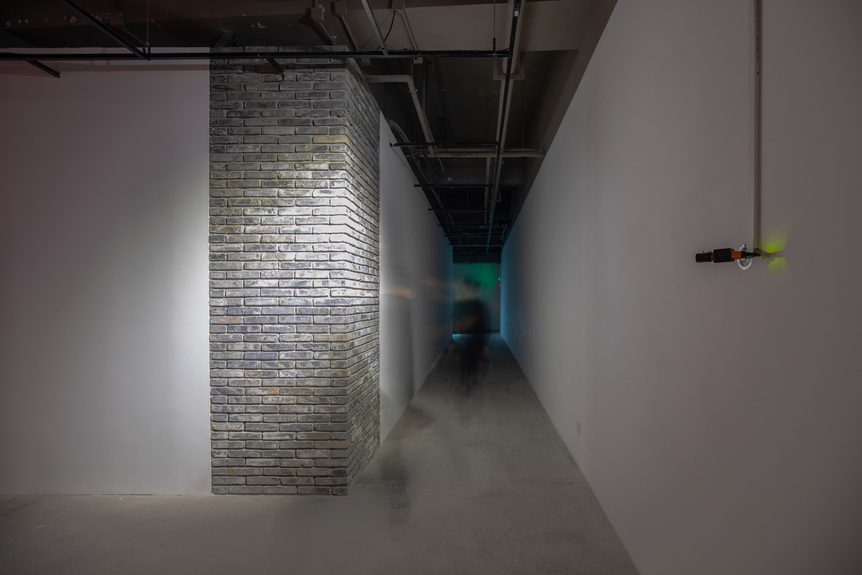-
From Current Issue
-
- Editor’s Letter Fire in the Heart
- Reviews I Gusti Ayu Kadek Murniasih
- Reviews 11th Seoul Mediacity Biennale: “One Escape at a Time”
- Dispatch Networked China
- One on One Monira Al Qadiri on Yukio Mishima
- Essays The rise of independent art spaces in pandemic-era Shanghai
- Features Tuan Andrew Nguyen
- Table of Contents
- Web Exclusives
- Archive
- Subscribe

R
E
V N
E
X
T
Installation view of KATSUHIRO YAMAGUCHI’s Las Menias, 1974–75, CCTV video installation (six CRT monitors, one video camera, and two print reproductions), live feed transmission, video on loop, color inkjet print on canvas, black and white inkjet print on paper, dimensions variable, at “Refocusing on the Medium: The Rise of East Asia Video Art,” OCAT Shanghai, 2020–21. Courtesy Mr. Hiroyasu Yamaguchi.
Projected footage of NAM JUNE PAIK’s TV Buddha, 1974/2002, CCTV video installation (limestone Buddha statue, CRT monitor, video camera), live feed transmission, at “Refocusing on the Medium: The Rise of East Asia Video Art,” OCAT Shanghai, 2020–21. Courtesy Nam June Paik Art Center, Yongin; and Nam June Paik Estate, New York.
“Refocusing on the Medium: The Rise of East Asia Video Art” at OCAT Shanghai assembled early video works by some of the key practitioners from Japan, Korea, and China, including Yoko Ono, Geng Jianyi, and Nam June Paik. The latter was represented here by his iconic TV Buddha (1974/2002), in which a statue of a buddha faces a live feed of itself on a TV. Instead of showing the actual installation, OCAT Shanghai projected footage of it broadcast from Yongin’s Nam June Paik Art Center—a set-up described in the curator’s introduction as a “distortion of time and space” that challenges the “dynamics connecting local and global aspirations.” Curatorial statement notwithstanding, it felt more like a pragmatic response to the difficulties of international lending in the present pandemic, as did the limited content and context in the exhibition.
Another question raised by Paik’s projection, per the curatorial text, regarded “the liveness of the medium”—a pertinent issue, given that for an exhibition of moving images, it was strangely static, quiet, and unmoving. The sparsely installed works felt unnaturally flat in the darkened space, an impression worsened by a lack of design. Squeezed into a small vestibule was Katsuhiro Yamaguchi’s wonderful Las Meninas (1974–75), an installation of CCTV cameras, two reproductions of the Diego Velázquez painting, and multiple monitors playing pre-recorded and live images of the space such that viewers are placed in the famous canvas. Yamaguchi’s intention to incorporate the “liveness” of the audience into his work, including our movement through the space, was undermined here by having little room between camera and subject. Similarly compromised was Wang Gongxin’s Two Square Meter Space (1995/2020), consisting of a live video image of an external brick wall projected onto an internal plasterboard wall. People outside can be in the image of the external brick wall, but not view being in it. Originally in a domestic space, the connection between locations, and the friction created by one’s inability to both perform and view, is explicit. Here, with the two parts of the work positioned far apart with other videos between them, the connection is lost and the friction dispelled. A similar problem occurred with Yoko Ono’s SKY TV (1966/2020), a live feed from a camera positioned on the roof of the exhibition building playing on a small monitor inside the gallery—yet without notice, the “liveness” eludes the passerby.
Equally problematic was the contention that video art arrived in Asia “with no cultural traditions, no significant conventions, or history,” ignoring more than a century of precedent in television, cinema, and photography, not to mention the experiments of Paik’s American and European contemporaries throughout the 1960s. Other questionable assertions were left unsupported, such as attributing video the status of “the first global contemporary art medium,” and locating the advent of the medium in China specifically in 1988, in reference to Zhang Peili’s 30 × 30 (1988), although the artist himself, who serves as executive director for OCAT Shanghai (probably the reason for the unfortunate absence of his work from the show) brings this into question in his preface for the exhibition, referring to it as a “misconception.”
Installation view of TAKAHIKO IIMURA’s TV for TV, 1983, CATV video installations (two identical CRT monitors face to face), live feed transmission, dimensions variable, at “Refocusing on the Medium: The Rise of East Asia Video Art,” OCAT Shanghai, 2020–21. Courtesy the artist and Microscope Gallery, New York.
Elsewhere, Takahiko Iimura’s TV for TV (1983) features two identical and untuned television monitors that face one another, their screens pressed so close together that the viewer can only make out the barest sliver of light escaping from the gap. The work was originally designed to broadcast whatever network was local to the exhibition site, so that these globally ubiquitous objects play locationally specific content that is, however, impossible to parse. It is an apt metaphor for an exhibition that proposed to re-examine “the artists’ approach to the video medium,” “show how the rise of East Asia video art developed,” and “give reason for a recalibration of thinking and reassessment,” all through the work of 15 artists and absent of accompanying text or contextual information. Not only was it impossible to glean these lofty goals, but even placing the artworks within a local practice, let alone a global history of the medium, proved difficult beyond name recognition.
Hutch Wilco is ArtAsiaPacific’s Shanghai desk editor.
“Refocusing on the Medium: The Rise of East Asia Video Art” is on view at OCAT Shanghai until March 21, 2021.
To read more of ArtAsiaPacific’s articles, visit our Digital Library.














